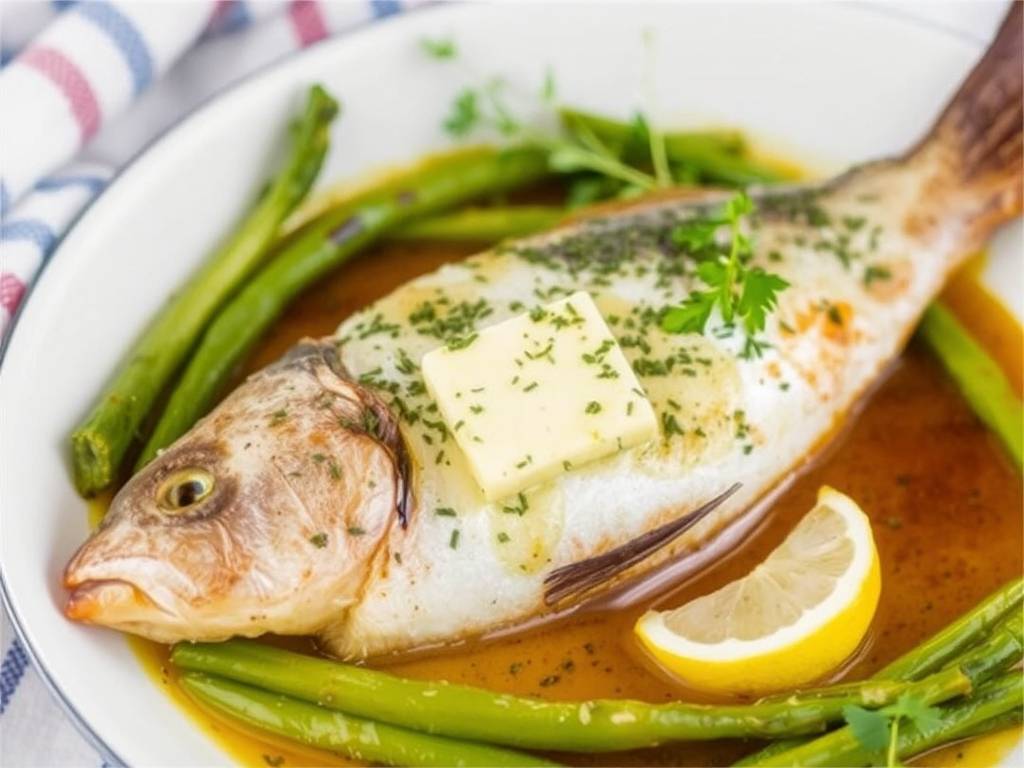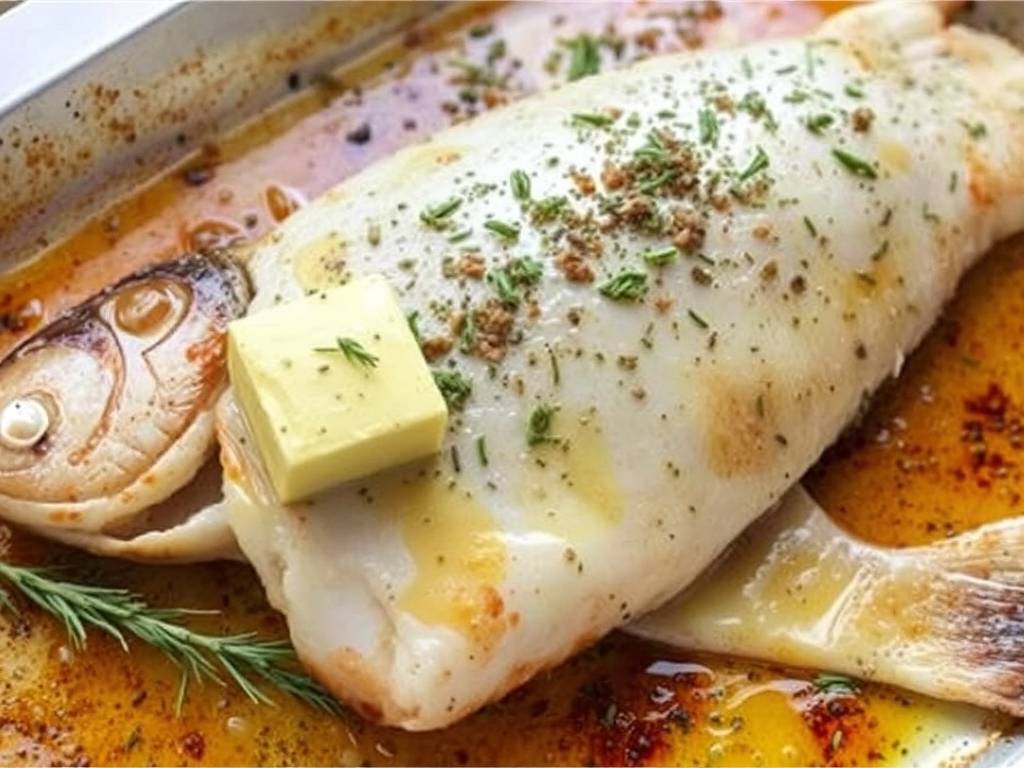The Ultimate Guide to Baking Fish with Butter and Herbs: A Simple Path to Flaky Perfection
There's something truly magical about baking fish with butter and herbs. The gentle heat of the oven coaxes out the delicate flavors of the fish, while the butter creates a rich, golden crust that locks in moisture. The herbs add that final touch of freshness and complexity, transforming a simple piece of fish into a gourmet meal. If you've ever felt intimidated by cooking fish, fearing it might turn out dry or bland, this guide is for you. We will walk through every step, from selecting the perfect fillet to achieving that restaurant-quality finish right in your own kitchen.
Why Baking is the Best Method for Flaky Fish

Many home cooks default to pan-frying fish, but baking is arguably the superior technique, especially when you're aiming for a healthy, hands-off approach. Baking fish in a butter and herb sauce ensures even cooking from all sides. The gentle, ambient heat of the oven cooks the fish through without the risk of a burnt exterior. This method is incredibly forgiving and perfect for busy weeknights or when you're cooking for guests. The key to this moist baked fish recipe is the combination of fat (butter) and low, consistent heat.
Selecting Your Fish: A Foundation for Flavor
The first step to a successful dish is choosing the right type of fish. For baking with butter and herbs, you want a fillet that is firm enough to hold its shape but tender enough to absorb the flavors.
- Best White Fish for Baking: Cod, halibut, haddock, and sea bass are excellent choices. They have a mild flavor that acts as a perfect canvas for the rich butter and aromatic herbs.
- Rich and Flaky Options: Salmon and trout are also fantastic. Their higher fat content pairs beautifully with the butter, creating an incredibly succulent result.
- What to Look For: Always seek out fresh, not previously frozen, fish if possible. The flesh should spring back when pressed lightly and have a clean, ocean-fresh smell. Avoid any fillets with a strong "fishy" odor.
The Butter and Herb Symphony: Crafting Your Flavor Profile
This is where the magic happens. Butter isn't just a cooking fat here; it's a key flavor component. I highly recommend using unsalted butter so you can control the sodium level. For the herbs, you have two fantastic paths: fresh or dried.
- Using Fresh Herbs: Fresh herbs provide a vibrant, bright flavor. A classic combination for baked fish recipes is a mix of chopped fresh dill, parsley, and chives. Thyme and rosemary are also wonderful, but use them sparingly as they are more potent.
- Using Dried Herbs: Dried herbs offer a more concentrated, earthy flavor. They are perfectly acceptable, especially out of season. A simple mix of dried dill, oregano, and a pinch of thyme works wonderfully.
The Ultimate Step-by-Step Guide to Baking Fish with Butter and Herbs
Let's get into the nitty-gritty. This easy baked fish recipe will become your new go-to.
Ingredients:
- 4 (6-ounce) white fish fillets (like cod or halibut), about 1-inch thick
- 4 tablespoons unsalted butter, melted
- 2 tablespoons fresh lemon juice
- 2 cloves garlic, minced
- 2 tablespoons finely chopped fresh herbs (parsley, dill, chives) or 2 teaspoons dried herbs
- Salt and freshly ground black pepper to taste
- Lemon slices for garnish
Instructions:
-
Preheat and Prepare: Start by preheating your oven to 400°F (200°C). This high heat is crucial for creating a slightly crispy top while keeping the inside tender. Take your fish fillets out of the refrigerator and pat them thoroughly dry with paper towels. This is a critical step for achieving a good sear in the butter and preventing the fish from steaming.
-
Create the Flavor-Packed Sauce: In a small bowl, combine the melted butter, fresh lemon juice, minced garlic, and your chosen herbs. Whisk them together until you have a fragrant, homogeneous sauce. This butter and lemon sauce for fish is the heart of the dish.
-
Season and Sauce: Lightly season both sides of the dry fish fillets with salt and pepper. Place the fillets in a single layer in a baking dish just large enough to hold them. You don't want them swimming in space, or the sauce will evaporate. Pour about two-thirds of the butter and herb sauce over the fish, ensuring each fillet is well-coated.
-
Bake to Perfection: Place the baking dish in the preheated oven. The cooking time will depend on the thickness of your fillets. A good rule of thumb is to bake for 10-15 minutes per inch of thickness. You'll know the fish is done when it turns opaque and flakes easily with a fork. An instant-read thermometer inserted into the thickest part should read 145°F (63°C). Do not overcook, as this is the primary cause of dry fish.

-
The Final Touch (Optional but Recommended): For an extra burst of flavor and a beautiful, golden finish, you can switch your oven to broil for the last 1-2 minutes of cooking. Watch it closely! This will brown the butter and herbs beautifully.
-
Serve and Enjoy: Remove the fish from the oven and immediately spoon the remaining butter sauce from the baking dish over the top. Garnish with fresh lemon slices and an extra sprinkle of fresh herbs. This simple baked fish with garlic and herbs is now ready to serve.
Solving Common Problems: Your Questions Answered
Even with a simple recipe, questions can arise. Let's address them all in one place.
- How do I know when the fish is done? The "flake test" is the most reliable method. Gently press a fork into the thickest part of the fillet and twist slightly. If the flesh separates into clean, opaque flakes, it's ready. If it still looks translucent and resists flaking, it needs more time.
- My fish always turns out dry. What am I doing wrong? The most common culprit is overcooking. Fish continues to cook for a minute or two after being removed from the oven (carryover cooking). Therefore, it's best to remove it just before it looks completely done. Using a thermometer to check for 145°F is your best insurance against dry fish.
- Can I use frozen fish? Absolutely. The best way to bake frozen fish fillets is to thaw them completely in the refrigerator overnight first. Then, pat them extremely dry before proceeding with the recipe. Baking frozen fish directly will release too much water and result in a steamed, rather than baked, texture.
- What sides go well with this? This dish is incredibly versatile. It pairs beautifully with roasted asparagus, green beans, a simple arugula salad, roasted baby potatoes, or a fluffy portion of quinoa or rice to soak up the delicious butter sauce.
- Can I make this a complete sheet pan meal? Yes! This is a fantastic time-saver. Place chopped vegetables like zucchini, bell peppers, and cherry tomatoes on a sheet pan. Toss them with a little olive oil, salt, and pepper. Place the seasoned fish fillets on top of the vegetables, pour the butter sauce over everything, and bake as directed. You'll have a complete, healthy dinner with minimal cleanup.
Baking fish with butter and herbs is not just a cooking method; it's a gateway to creating elegant, healthy, and deeply satisfying meals with ease. By mastering this fundamental technique, you unlock a world of culinary possibilities. So, the next time you're wondering what to make for dinner, remember this guide. Grab a fresh fillet, some butter, and your favorite herbs, and let your oven do the work. You'll be rewarded with a dish that is sure to impress.






发表评论